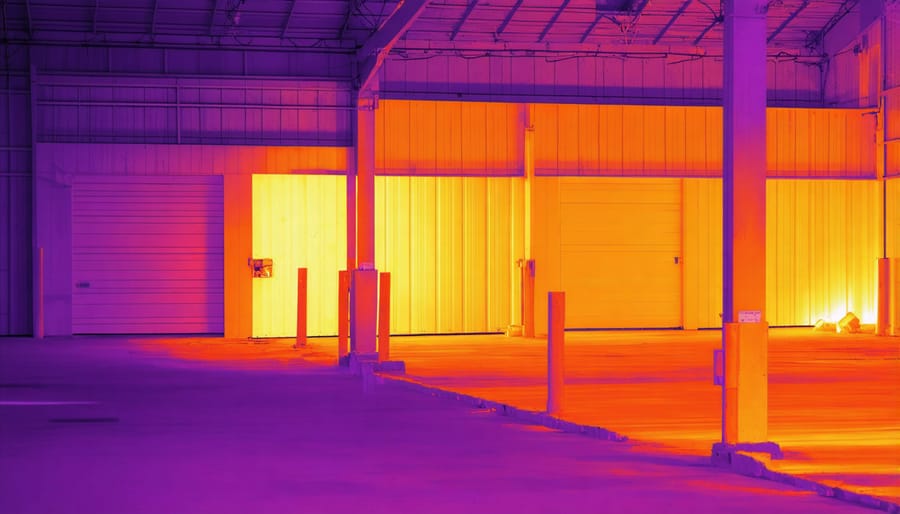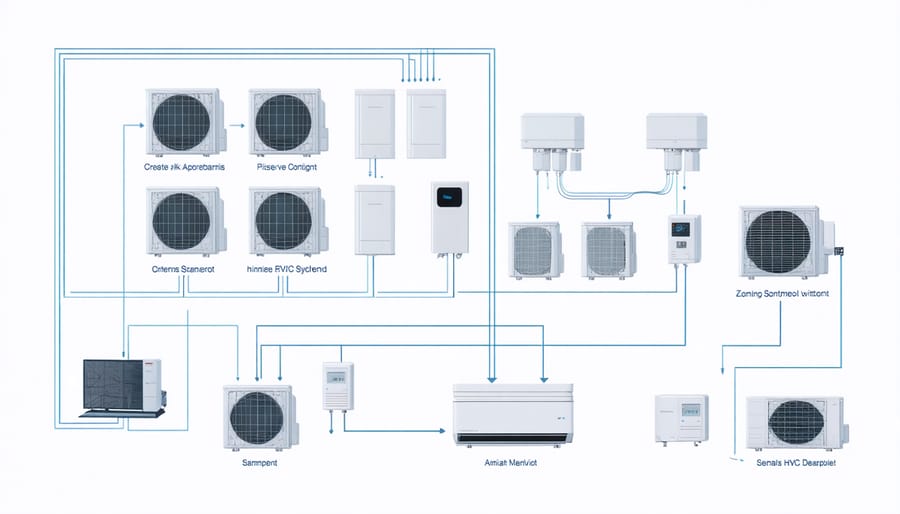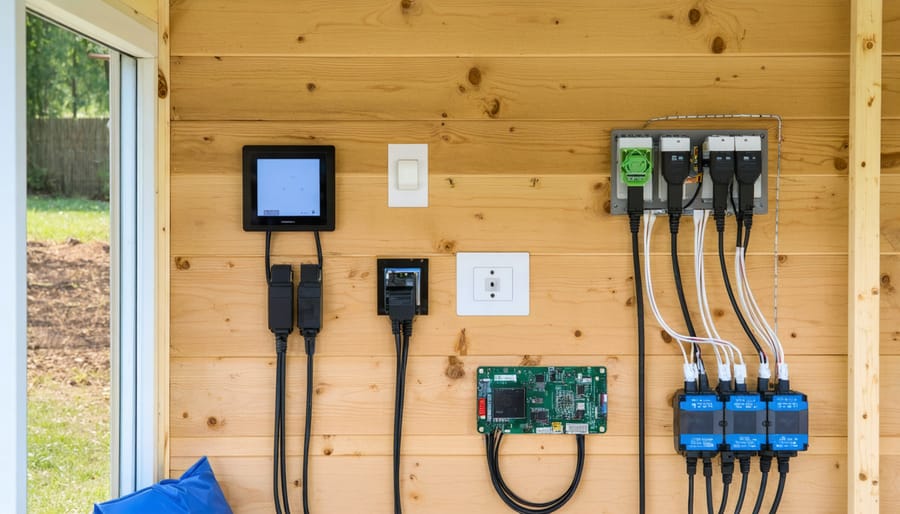Smart HVAC Zoning Makes Your Storage Shed Actually Comfortable

Transform your storage space into a climate-controlled sanctuary with smart HVAC zoning – the intelligent solution that lets you maintain optimal storage conditions while maximizing energy efficiency. By dividing your shed into distinct temperature zones, each controlled by individual thermostats and dampers, you gain precise control over heating and cooling exactly where you need it. Modern smart zoning systems integrate seamlessly with home automation platforms, allowing remote monitoring and adjustment through your smartphone. This targeted approach not only protects sensitive items from temperature fluctuations but also reduces energy costs by up to 30% compared to traditional single-zone systems. Whether you’re storing temperature-sensitive equipment, preserving valuable collections, or creating a comfortable workspace, smart HVAC zoning delivers personalized climate control that adapts to your specific storage needs.
Why Traditional Shed Climate Control Falls Short
Hot Spots and Cold Corners
Temperature variations in sheds can be frustrating and potentially damaging to stored items. Common issues include hot spots near windows or metal walls that absorb sunlight, and cold corners where air circulation is poor. These inconsistencies often occur because traditional single-zone systems treat the entire space as one unit, despite different areas having unique heating and cooling needs. The roof area typically becomes the warmest zone due to rising heat, while floor-level spaces remain cooler. Corners furthest from vents tend to develop stagnant air pockets, creating microclimates that can lead to moisture problems and affect stored items differently. Understanding these patterns is crucial for implementing an effective smart zoning solution that can maintain consistent temperatures throughout your shed.

Energy Waste in Single-Zone Systems
Traditional single-zone HVAC systems treat your entire home as one space, leading to significant energy waste and comfort issues. When your thermostat calls for heating or cooling, it activates the system based on the temperature in just one location, typically your main living area. This means unused rooms receive the same conditioning as frequently occupied spaces, consuming unnecessary energy and increasing utility bills.
For example, if you’re working from home in your office, your HVAC system might be heating or cooling empty bedrooms, guest rooms, and rarely used spaces to the same temperature. This one-size-fits-all approach not only wastes energy but can also create temperature imbalances throughout your home, with some rooms feeling too hot while others remain too cold.
Beyond energy waste, single-zone systems often struggle to maintain consistent comfort levels across different floors or in rooms with varying sun exposure.

Smart HVAC Zoning: How It Works
Temperature Sensors and Smart Controls
Effective temperature monitoring is the backbone of any smart zoning HVAC system. Modern sensors provide precise readings throughout your space, working together with intelligent controls to maintain ideal conditions. When implementing a monitoring system for your shed, you’ll find a range of options from basic wireless thermostats to advanced multi-point sensors.
Smart temperature sensors communicate wirelessly with your central control hub, providing real-time data about conditions in different zones. These sensors can detect not just temperature, but also humidity levels, helping prevent moisture-related issues that often plague storage spaces. Many modern systems include smartphone integration, allowing you to monitor and adjust settings remotely through user-friendly apps.
The control systems work by processing sensor data and automatically adjusting airflow through motorized dampers. You can set different target temperatures for each zone and create custom schedules that align with your usage patterns. Some advanced systems even learn from your preferences over time, automatically adjusting to maintain optimal comfort while maximizing energy efficiency.
For reliability, look for sensors with long battery life and strong wireless range. Many homeowners find that placing sensors at both floor and ceiling levels provides the most accurate temperature readings for effective zone control.
Zone Dampers and Air Flow Management
Zone dampers are the workhorses of a smart zoning HVAC system, acting like traffic controllers for your home’s conditioned air. These motorized devices open and close automatically to direct airflow precisely where it’s needed. When one zone calls for heating or cooling, the corresponding damper opens while others may partially or fully close, ensuring efficient air distribution.
Modern smart dampers use sophisticated sensors to monitor air pressure and flow rates, preventing any strain on your HVAC system. They work in harmony with your smart thermostat, responding to temperature readings and occupancy patterns in different areas of your home. Some systems even feature pressure bypass dampers that redirect excess air when multiple zones are closed, maintaining optimal system performance.
The beauty of this setup lies in its flexibility. You can customize airflow patterns based on your daily routine – directing more air to bedrooms at night or focusing on living areas during the day. Many smart dampers also include built-in position indicators and diagnostic features, making it easy to monitor their operation and troubleshoot any issues.
For maximum efficiency, these dampers can be programmed to adjust gradually, preventing the sudden pressure changes that could stress your HVAC system or create unwanted noise.
Setting Up Smart Zones in Your Shed
Mapping Your Storage Areas
Before implementing a smart HVAC zoning system, it’s crucial to map out your storage areas effectively. Start by creating a detailed floor plan of your space, noting the locations of different items and their specific climate control needs. Consider grouping temperature-sensitive items together, such as electronics, wooden furniture, or seasonal decorations.
Pay special attention to areas that might require different temperature settings. For example, a section storing paint and chemicals might need cooler temperatures than areas housing fabric items. Create designated zones based on both storage content and natural temperature variations within your space.
Take note of external factors that could affect different areas. Windows, doors, and insulation quality can create temperature variations that influence your zoning decisions. Map out sunny spots versus shaded areas, as these will require different cooling approaches throughout the day.
Consider traffic patterns and accessibility when planning your zones. Frequently accessed areas might benefit from separate temperature control compared to long-term storage sections. This helps optimize energy usage while maintaining appropriate conditions for your stored items.
Don’t forget to account for future storage needs. Leave some flexibility in your zoning plan to accommodate changes in storage requirements. A well-thought-out mapping strategy ensures your smart HVAC zoning system operates efficiently while protecting your valuable items.
Installing Smart Controls
Installing smart controls for your zoned HVAC system is simpler than you might think. Start by turning off power to your HVAC system at the circuit breaker for safety. Next, remove your existing thermostat and note the wire connections – taking a quick photo can be helpful for reference.
Mount your new smart zone controller in a central location, typically where your main thermostat was previously installed. Connect the labeled wires to their corresponding terminals on the new controller, following the manufacturer’s wiring diagram carefully. Most modern smart controllers are color-coded to make this process straightforward.
Install the zone sensors in each area you want to control independently. These typically mount on interior walls, away from direct sunlight, air vents, and heat sources. Connect these sensors to your main controller following the included instructions.
Download your system’s corresponding mobile app and follow the setup wizard to connect your controller to your home’s WiFi network. The app will guide you through naming your zones and setting initial temperatures.
Finally, restore power to your HVAC system and verify that each zone responds correctly to temperature adjustments. Take time to familiarize yourself with the app’s features, including scheduling options and zone-specific settings. Many systems also offer voice control integration with popular smart home platforms for added convenience.
Pro tip: Keep your installation manual handy for the first few weeks as you fine-tune your system’s settings for optimal performance.

Maintenance and Optimization Tips
To keep your smart zoning HVAC system running efficiently, establishing a regular maintenance schedule is essential. Start by checking and cleaning your zone dampers every three months to ensure smooth operation. Clean or replace air filters monthly, as clogged filters can reduce system efficiency and impact air quality.
Regularly inspect your smart thermostats and sensors for accurate readings. Clean them gently with a soft, dry cloth and check battery levels if applicable. Update your system’s software whenever new versions become available to ensure optimal performance and security.
Monitor your system’s performance through the app or control panel. Look for unusual patterns in temperature variations or energy usage, which might indicate the need for adjustments or repairs. Season-specific optimization is also important – adjust your zoning schedules for summer and winter to maximize efficiency.
Don’t forget to check ductwork annually for leaks or damage, especially in areas where ducts connect to zone dampers. Consider having a professional HVAC technician perform a comprehensive system check at least once a year. They can calibrate your zones, verify proper damper operation, and ensure all components are working together seamlessly.
For optimal results, keep vents unobstructed and regularly clean return air grilles. This simple step can significantly improve airflow and system efficiency throughout your zoned spaces.
Smart zoning HVAC systems represent a game-changing solution for homeowners seeking better climate control in their storage spaces. By implementing this technology, you can enjoy reduced energy costs, improved comfort, and protection for your valuable belongings. The ability to precisely control temperature and humidity in different zones ensures that every corner of your storage space maintains optimal conditions. Making the switch to a smart zoning system is more accessible than ever, with various options available to suit different budgets and needs. Whether you’re storing sensitive items or simply want more efficient climate control, the benefits of smart zoning HVAC make it a worthwhile investment for any storage space. Take the first step toward smarter storage by exploring the zoning options available to you – your belongings and your energy bill will thank you.

